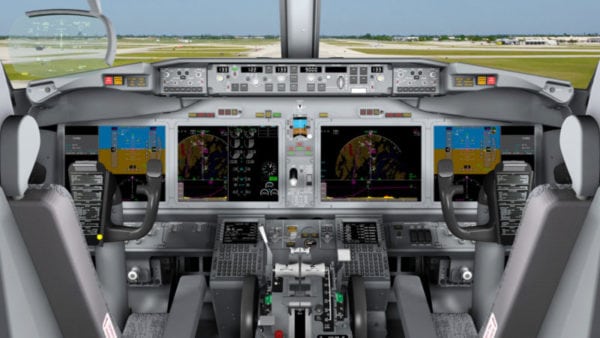
737 MAX Flight Deck. Photo courtesy of Boeing
Seven new ARINC Standards and 13 supplements to existing standards have reached an industry consensus for the 2018 annual Airlines Electronic Engineering Committee (AEEC) and Avionics Maintenance Committee (AMC) general session. Ahead of the annual gathering of airline avionics engineers and maintenance technicians, Avionics caught up with Paul Prisaznuk, executive secretary and program director at AEEC, to understand the focus of the two-sided event this year.
The annual general session brings together some of the biggest names in the industry to foster competitiveness and interchangeability on today’s airframes. Also interesting is the way in which the standardization that evolves and comes out of the subcommittee collaboration leads to standardization of products that enable the communications, navigation and surveillance (CNS) capabilities necessary to move airspace modernization initiatives such as NextGen in the U.S. and the Single European Sky (SES) forward.
The event is two sided. One side makes up the AEEC general session, consisting of member airlines, the U.S. Air Force, Airbus and Boeing voting on the adoption of new ARINC standards, while also discussing some of the aviation industry’s most technologically advanced and complex issues. ARINC characteristics, specifications and reports help define the form, fit and function, and interfaces to avionics equipment and associated networks, physical packaging, databuses and software operating system and electrical interfaces that power flights on modern aircraft around the world every day.
The other side of the event is the AMC general session, where maintenance leaders from the world’s biggest airlines discuss solutions to ongoing maintenance issues for in-service commercial airframes.
AEEC 2018
CNS/ATM standards are among the highest priority for the AEEC. These standards drive aviation infrastructure improvements and, with the help of air navigation service providers (ANSPs), deliver airline operating efficiencies and higher profitability, according to Prisaznuk.
“In the communications area, our update to ARINC 771, Iridium Certus/NEXT satcom standard will enable airlines to obtain truly global datalink coverage at speeds up to 350 kbps uplink and 700 kbps downlink. This avionics definition is ready to go. Modem suppliers are developing products. Iridium says that it plans to have a full constellation in orbit by the end of this year and offer Certus services in 2019,” Prisaznuk told Avionics.
Members of AEEC will also consider a fifth supplement to ARINC 702A, a flight management computer standard, that will enable aircraft use required navigation performance (RNP) standards published in RTCA DO-236C.
In the area of surveillance, ARINC 813 and ARINC 815 are designed to leverage user requirements for terrain and obstacle data found in RTCA DO-276, according to Prisaznuk. When the databases featured in these standards are integrated into navigation and surveillance platforms, they can enable new airborne applications such as terrain and avoidance warning systems and vertical situation displays, he said.
During the four-day general session, AEEC’s executive committee will also feature a symposium focusing on big data. The focus there is to discuss the reality that current aircraft such as the Airbus A350 and Boeing 787 can generate up to 10 terabytes of data per day depending on the routes they fly. The use of cloud computing to capture that data is increasingly being adopted by airlines, and there is a need for data security standards to optimize this concept, according to Prisaznuk.
“AEEC’s Internet Protocol Suite (IPS) Subcommittee is leading an effort to define, IP services using IPv6 addressing and security using Public Key Infrastructure (PKI). Initially these IPS services are intended for safety service applications. And looking down the road further, these same secure IP services can be applied to all types of networks and infrastructure. A big enabler for big data,” said Prisaznuk.
AMC 2018
AMC’s session features an open forum, where airline maintenance engineers discuss issues with in-service commercial aircraft avionics hardware and software. The large assortment of wiring, receivers, interconnection systems and circuitry that enables the use of avionics is also a focus for the maintenance committee.
The three main symposiums for AMC this year include an introduction to big data Monday, an ADS-B mandate symposium Tuesday and a symposium Wednesday, focusing on the latest design and reliability issues associated with pitot static designs.
“I am very pleased to say that all ARINC Standards have been prepared and published for the airlines, OEMs, and their suppliers to meet the ADS-B mandates around the world and including Equip 2020 in the USA. This includes ARINC 718A Mode S Transponder Standards, ARINC 735B Traffic Computer Standards (TCAS + ADS-B), and ARINC 768 Integrated Surveillance System (ISS) Standards,” said Prisaznuk.